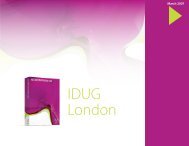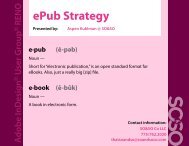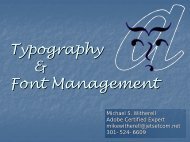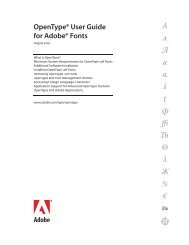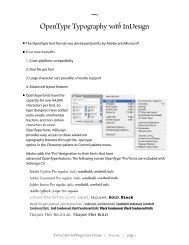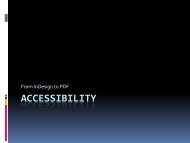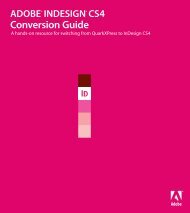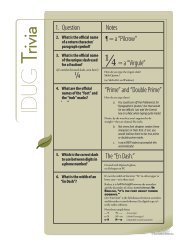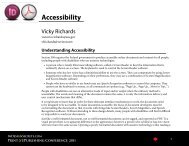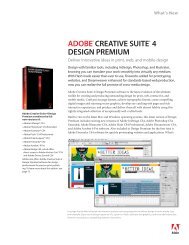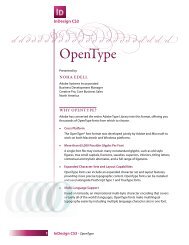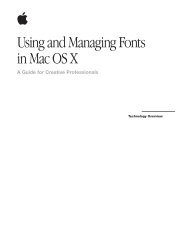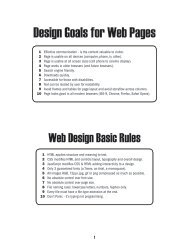Quark to InDesignCS3 Conversion Guide - InDesign User Group
Quark to InDesignCS3 Conversion Guide - InDesign User Group
Quark to InDesignCS3 Conversion Guide - InDesign User Group
You also want an ePaper? Increase the reach of your titles
YUMPU automatically turns print PDFs into web optimized ePapers that Google loves.
how do I flow text along a path?<br />
The process of flowing text along<br />
a path is different in <strong>InDesign</strong> and<br />
in <strong>Quark</strong>XPress. In <strong>Quark</strong>XPress,<br />
you must use the Text Path <strong>to</strong>ols,<br />
and you can run text along straight<br />
or curved lines only and not along<br />
closed paths. <strong>InDesign</strong> lets you<br />
use any object as a path for type.<br />
The first step in creating a type path<br />
in <strong>InDesign</strong> is <strong>to</strong> create the object<br />
that will be the path. You can use<br />
any of the drawing <strong>to</strong>ols, and you<br />
can create an open or a closed shape.<br />
After you’ve created an object,<br />
choose the Type On A Path<br />
<strong>to</strong>ol, which is paired with<br />
the Type <strong>to</strong>ol in the Tools<br />
panel, and then move the pointer<br />
over a path. A plus sign (+) is displayed<br />
when the pointer is over any<br />
part of the path of the object. When<br />
the plus sign is displayed, click anywhere<br />
on the path. When you release<br />
the mouse but<strong>to</strong>n, the blinking text<br />
insertion point indicates where text<br />
will be placed when you enter or<br />
import text. If you click and drag<br />
the pointer along the path before<br />
you release the mouse but<strong>to</strong>n, text<br />
flows only along the part of the path<br />
on which you clicked and dragged.<br />
If you select a path type with the<br />
Selection <strong>to</strong>ol, the path’s bounding<br />
box and resizing handles are displayed.<br />
In and out ports are also displayed,<br />
which means you can thread<br />
text in<strong>to</strong> and out of a path type, and<br />
you can thread text between a path<br />
type and a text frame, and vice versa.<br />
Three bracket lines are displayed on<br />
a type path: one at each end, and a<br />
shorter one at the midpoint. Click<br />
and drag these bracket lines <strong>to</strong> adjust<br />
the placement of type along the path.<br />
To change the shape of a path type,<br />
select the Direct Selection <strong>to</strong>ol, and<br />
click and drag points or segments.<br />
how can I modify type along a path?<br />
When path type is selected, choosing<br />
Type > Type On A Path > Options<br />
displays the Path Type Options<br />
dialog box. (You can also use the<br />
context menu <strong>to</strong> open the Path Type<br />
Options dialog box.) You can choose<br />
any of five Effect options: Rainbow,<br />
Skew, 3D Ribbon, Stairstep, and<br />
Gravity. Other controls let you specify<br />
the placement of the type relative<br />
<strong>to</strong> the path and the spacing of characters<br />
around corners and angles.<br />
the type On A Path <strong>to</strong>ol<br />
lets you use any object<br />
as a path for type, and<br />
you can use any of the<br />
program’s typographic<br />
features <strong>to</strong> format type<br />
on a path.<br />
Combining Text and Graphics 65




